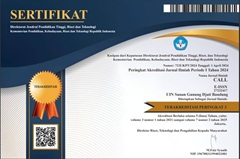DIRECTIVE ACTS IN ONWARD FILM BY DAN SCANLON
DOI:
https://doi.org/10.15575/call.v3i2.14878Abstract
This study aims to describe the types of directive acts contained in the Onward film using the theory of Keith Allan (1986). The subject of this study is the main characters of the Onward film by Dan Scanlon. This qualitative-descriptive study collected data from the main characters’ utterances of the film in the form of words, phrases, or sentences that contain directive acts in each scene of the Onward film. The researchers collected data by listening, recording, and note-taking to obtain complete and reliable data on various forms of directive acts. The researchers as the main instruments analyzed the data in four stages: identification, classification, interpretation, and conclusion. The results of the analysis of 51 directive acts show six kinds of directive acts, that is, advice, requirements, permissions, prohibitions, questions, and requests with questions as the most dominant ones.
Â
Keywords: Speech Acts, Directive Act, Film Dialogues, Onward Film
References
Al-Farisi, R. (2018). Directive Illocutionary Act Used In Al- Qur’an Surah Ali Imran (Undergraduate’s Thesis). State Islamic University of Sunan Ampel, Surabaya.
Allan, K. (Ed.). (1986). Linguistic Meaning (2nd ed). London: Routledge & Kegan Paul plc.
Amanda, V. & Leni, M. (2018). Directive Speech Acts Used in Frozen Movie Transcript. English Language and Literature, 7.(1), 2302-3546. Retrieved from https://doi.org/10.24036/ell.v7i1.9914
Austin, J.L. (1962). How to Do Things with Words. Oxford: Oxford University Press.
Chairunisa, P., & Ariatmi, S. (2018). A Pragmatics Analysis of Directive Utterances by Syria President Bashar Al Assad in News Interviews (Undergraduate’s Thesis). Muhammadiyah University, Surakarta.
Fishman, P. M. (1983). Interaction: The work woman do. In N. T. Barrie, K. Cheris & N. Henley (Eds.), Language Gender and Society (pp. 89-102). Rowley, USA: Newbury House.
Herman. (2015). Illocutionary Acts Analysis off Chinese in Pematang siantar. International Journal of Humanities and Social Science Invention, 4(12), 2321-9203. Retrieved from: http://repository.uhn.ac.id/handle/123456789/630
Ibrahim, A. S. (1993). Kajian Tindak Tutur. Surabaya; Usaha Nasional.
Lakoff, R. (1975). Linguistic theory and the real world. Language Learning, 25(2), 309-338. https://doi.org/10.1111/j.1467-1770.1975
Leech, G.N. (1983). Pragmatics. Cambridge, UK: Cambridge University Press.
Levinson, S.n C. (1983). Pragmatics. Cambridge, UK: Cambridge University Press.
Litosseliti, L. (2010). Research Methods in Linguistics. London. Continuum International Publishing Group Ltd.
Oktavia, S., Suwandi, S., & Setiawan, B. (2020). Directive Speech Act in Interactive Videos of Indonesian Language Learning in Senior High School. International Journal of Multicultural and Multireligious Understanding, 7(11), 2364-5369. Retrieved from http://dx.doi.org/10.18415/ijmmu.v7i11.2163
Oktoberia, L. (2012). Types of Directive Speech Acts Used in Harry Potter-The Deathly Hallows and Bride Wars movie scripts. English Language and Literature, 1(1), 2302-3546. Retrieved from http://ejournal.unp.ac.id/index.php/ell/article/view/1815/1553
Rashid, A., Mat, N. H., Kamaruzaman, A. S., Ibrahim, M. Y., Che Noh, C. H., Chua, N. A., & Satoshi, M. (2021). The Use of Japanese Language Directive Speech Acts by Malaysian Tour Guides. Journal of Nusantara Studies (JONUS), 6(2), 358-378. Retrieved from: https://doi.org/10.24200/jonus.vol6iss2pp358-378
Searle, J. R. (1969). A Theory of Speech Acts. Cambridge, UK: Cambridge University Press.
Suryanovika, C., & Julhijah, N. (2018). Directive speech acts and hedges presented by female main charactersss of Jane Austen’s novels. Lingua Cultura, 12(4), 345-350. Retrieved from: https://doi.org/10.21512/lc.v12i4.4118
Tewksbury, R. (2009). Qualitative versus Quantitative Methods: Understanding Why Qualitative Methods are Superior for Criminology and Criminal Justice. Journal of Theoretical and Philosophical.
Vanderveken, D. (Ed). (1990). Meaning and Speech Acts: Principle of Language Use (1st ed). Cambridge, UK: Cambridge University Press.
Widodo, A.T. (2019). Directive Speech Acts found in “13 Reasons Why†Serial Movie by Joseph Incaprera (Undergraduate’s Thesis). State Islamic University of Sunan Ampel, Surabaya.
Yule, G. (1996). Pragmatics. New York: Oxford University Press.
Yule, G. (2000). The Study of Language. Cambridge, UK: Cambridge University Press.
Downloads
Published
Issue
Section
Citation Check
License
Authors who publish in CALL agree to the following terms:
- Authors retain copyright and grant the journal right of first publication with the work simultaneously licensed under Attribution-ShareAlike 4.0 International (CC BY-SA 4.0) License that allows others to share the work with an acknowledgment of the work's authorship and initial publication in this journal.
- Authors are able to enter into separate, additional contractual arrangements for the non-exclusive distribution of the journal's published version of the work (e.g., post it to an institutional repository or publish it in a book), with an acknowledgment of its initial publication in this journal.
- Authors are permitted and encouraged to post their work online (e.g., in institutional repositories or on their website) prior to and during the submission process, as it can lead to productive exchanges, as well as earlier and greater citation of published work (See The Effect of Open Access).




